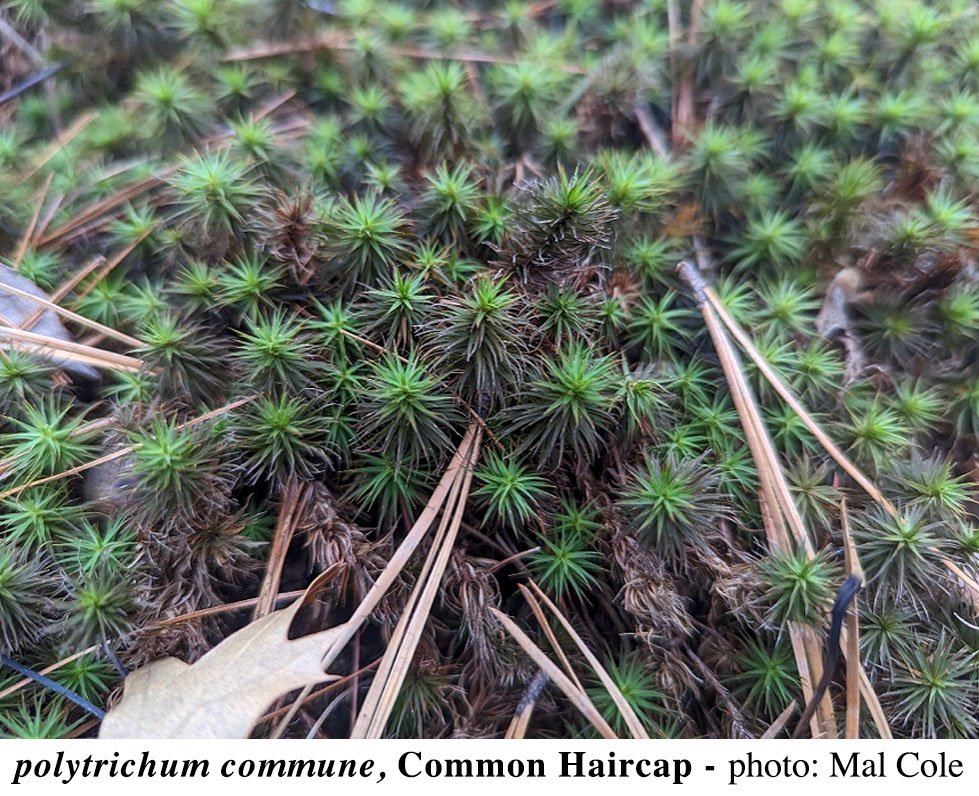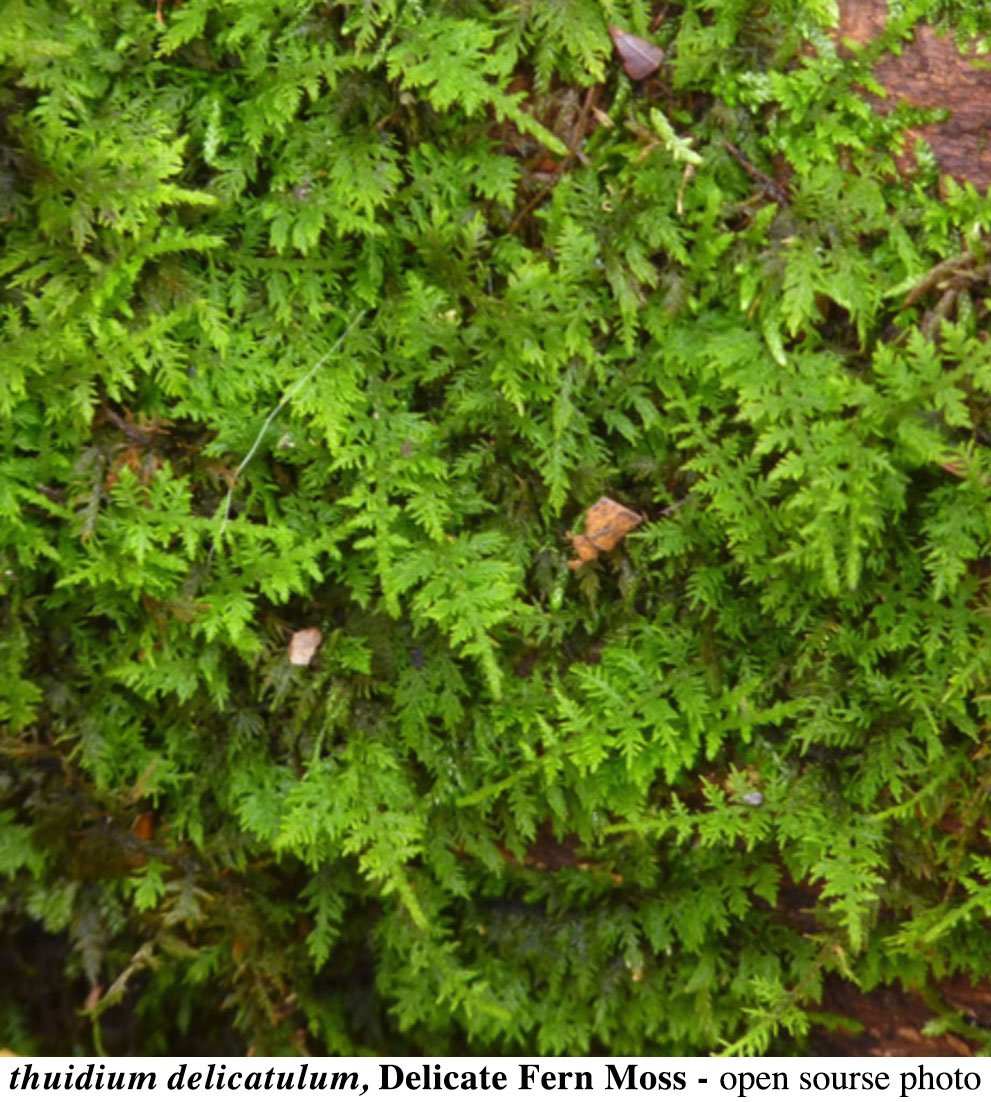by Mal Cole
It’s hard to see a moss for what it really is. As part of an ecosystem, and in art, moss can seem like an afterthought—a sprig of parsley at the edge of an already appealing plate. But moss is so much more than harmless decoration. If we look closely at mosses we can see their diversity and also their beauty.
Mosses are colonies of individual plants, some resembling tiny trees, some more fern-like, and some even seem amorphous to the naked eye. Often, we use textile terms to describe the look of a moss. We might call a large expanse a “carpet” or a tiny tuft a “velvet pillow” or “cushion”. Moss also ranges in colors from yellow to silvery blues and can even be bioluminescent in the case of Schistostega pennata (also called goblin gold). We find moss in almost every environment from rainforest to desert. And, if that isn’t enough to entice an artist, it can serve not only as a subject but also a setting. If we look beyond the surface of the moss and into its interior, we can see that moss has all the appurtenances of a tiny world, including its own flora and fauna.
Some Common New England Mosses and How to Identify Them
Moss identification can be challenging, even for an experienced naturalist. At first glance moss structures can seem so small as to be almost inscrutable and so different as to be incomparable. Common names do us few favors in trying to identify mosses. Spanish moss (Tillandsia usenoides)? Not a moss! Reindeer moss (Cladonia rangeferina)? It’s a lichen! Scientific names of mosses tend to be complex and difficult to remember, and few mosses have familiar common names. But perhaps we can take a cue from the mosses and start small.
Robin Wall Kimmerer, author of the inspiring book Gathering Moss: A Natural and Cultural History of Mosses, suggests that the most important tool for identifying mosses is simply learning to see how unique they are. From far away moss can read like a formless blob of green, but a bryologist like Kimmerer can instantly recognize it by its very nature—its way of being. “That certain green, the way it catches the light, gives away its identity, like recognizing the walk of a friend before you can see their face,” she says. A moss is never just a moss to Kimmerer, just as a tree is never just a tree— it’s, an oak, a beech, an aspen, a spruce. All of trees are so different and totally unique to a tree expert. It’s the same with mosses. The tiny tree shaped gametophytes of Polytrichum commune (Common Haircap Moss) are so different from the fern-like structures of Thuidicum delicatulum (Delicate Fern Moss).
Several good guides to mosses exist, and guides that are specific to a region are often easier to navigate. (I like Common Mosses of the Northeast and Appalachians by Karl B. Micknight and colleagues.) INaturalist, an app developed by the California Academy of Sciences can also be a helpful tool for the aspiring bryologist. But as Kimmerer says, our first step is learning to see: first we notice the silvery blue of Leucobryum glaucum (pincushion moss) and then the chenille throw like texture of the enticingly named Entodon sedutrix (Seductive Entodon Moss). Once we’re well acquainted, these little botanical treasures will find their way into our memories and our artwork.
A Miniature World
Three hundred fifty million years ago, mosses, which are related to algae, were the first plants to make their way to land. Long before there was a redwood forest, mosses provided an early habitat for a brand-new world. And mosses are still pioneers when it comes to inhabiting inhospitable places like cold soilless stone or even rooftops. Gardeners will find mosses growing in the most unlikely places where nothing else would think to grow— in deepest shade, on the trunks of trees, and between the bricks on a patio.
In her book Kimmerer describes an experiment performed by one of her students, who tracked the restorative potential of mosses on the inhospitable site of a former mine. Because they don’t require soil to grow, mosses may be able to help restore sites where the erosion and pollution have destroyed the potential for growth. Mosses tiny structures trap leaf litter and windswept particles to create soils and grow seeds. Mosses mean more life is on the way. And it’s not just plant life: a gram of moss can harbor hundreds of thousands of tiny invertebrates barely visible to the naked eye. The tardigrade, also known as a “water bear” or even “moss piglet”, is a chubby little creature that can live almost anywhere but often prefers a mossy home. Springtails are a mere 1/8th of an inch long but are able to jump several inches due to an appendage or “tail” called a furcula under their abdomen. The rotifer is a tiny animal whose name comes from the Latin word for “wheel-bearer.” This is because of a unique ring of cilia that surrounds their mouthparts.
With all these microfauna to marvel at, we can easily imagine moss as a forest, and the potential for moss as a subject and setting is endless. Perhaps this is what draws those of us who love mosses into their depths. A moss is so much more than what we can see on the surface, and that is a comforting thought. Who, really, wants to be taken purely at face value? “Every day we pass over them without seeing.” says Kimmerer. “Mosses and other small beings issue an invitation to dwell for a time at the limits of ordinary perception. All it requires of us is attentiveness. Look in a certain way, and a whole new world can be revealed.” There are infinite worlds to explore right at the base of a tree. Everything is so much more than it seems in the miniature world of mosses.
Sources
Print Sources:
Bland, John. Forests of Lilliput: The Realm of Mosses and Lichens. Englewood Cliffs: Prentice-Hall, 1971.
Kimmerer, Robin Wall. Gathering Moss: A Natural and Cultural History of Mosses. Corvallis: Oregon State University Press, 2003.
McKnight, Karl B., Joseph R. Roher, Kirsten McKnight Ward, and Warren J. Perdrizet. Common Mosses of the Northeast and Appalachians. Princeton and Oxford: Princeton University Press, 2014.
Schenk, George. Moss Gardening: Including Lichens, Liverworts, and Other Miniatures. Portland: Timber Press, 1997.
Web Sources:
Hahn, Jeffrey and Stephen Kells. “Springtails,” University of Minnesota Extension. Updated 2018. Accessed January 31, 2019. https://extension.umn.edu/nuisance-insects/springtails
INturalist; “Mosses of the Northeast.” https://www.inaturalist.org/projects/mosses-of-the-northeast
National Geographic; National Geographic online “Tardigrade” entry. https://www.nationalgeographic.com/animals/invertebrates/facts/tardigrades-water-bears
Simmons, Paul, “Goblin’s Gold Luminous Moss Continues To Captivate” Plantwatch (column), The Guardian, January 19, 2022, https://theguardian.com/science/2022/jan/19/plantwatch-goblins-gold-luminous-moss-schistostega-pennata-caves-glowing-green-light
University of California Museum of Paleontology, “Introduction to the Rotifera: Rotifers: the ‘wheel animalcules.’” Accessed January 31, 2023. https://ucmp.berkeley.edu/phyla/rotifera/rotifera.html
University of British Columbia: Biology 321 Course Website; “Introduction to Moss Morphology” http://www3.botany.ubc.ca/bryophyte/mossintro.html





